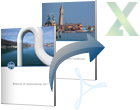Dear Stakeholders,

Carlo Malacarne
CEO
Even in a scenario characterised by extreme market volatility and dampened growth prospects for the world economy, Snam achieved significant operating and financial results in 2011. Confirming Snam’s operating efficiency, operating profit and earnings before tax last year were up 5.2% and 3.5% respectively compared to 2010.
Operating profit for 2011 stood at €1,958 million, increasing by €96 million compared to 2010. Net profit for 2011 was €790 million, down by €316 million. This result is strongly correlated with recent fiscal measures passed by the government to repair the public finances and, in particular, with the application of the additional IRES income tax (the “Robin Hood tax”) being extended to entities operating in the natural gas transportation and distribution sector. The continual focus on operating efficiency also enabled us to reach the cost-cutting target announced for 2012 a year early.
Snam shares ended 2011 at an official price of €3.39, dropping 9.1% from the previous year. The Company’s annual share performance was affected by the negative performance of Italian and European financial markets in general and in particular by the extension of the “Robin Hood tax” to regulated companies in the domestic energy sector. The shares nevertheless outperformed the Italian market (FTSE MIB: -25.2%) and the European utilities sector (Stoxx Europe 600 Utilities: -16.6%), buoyed by interest in shares of companies with solid business fundamentals and long-term earnings and cash flow visibility.
Besides staying in the major sustainability indices, including the Dow Jones Sustainability Index World, the share joined the Stoxx Global ESG Leaders indices, a new group of indices of 1,800 listed companies worldwide based on a transparent performance selection process, in terms of sustainability. This result validates Snam’s ongoing focus on sustainable growth, which is also expressed through its active support of the Global Compact, its principles and of the Millennium Development Goals in general.
December 2011 saw the completion of the process for the new organisational structure, which went into effect on 1 January 2012. Placed at the helm under the group’s new corporate structure is Snam S.p.A., which holds 100% of the share capital of the four operating companies (Snam Rete Gas S.p.A., GNL Italia S.p.A., Stogit S.p.A and Italgas S.p.A.) focused on managing and developing their respective businesses: natural gas transportation and dispatching, regasification, storage and distribution. It is a fundamental changeover, ratifying compliance with the EU provisions contained in the “Third Energy Package” by implementing the ITO (Independent Transmission Operator) model, which calls for the separation of the transporter in terms of both functioning and decision-making from the vertically integrated company (Eni) operating in the gas sales sector.
During the year just ended, Snam continued its commitment to increasing system security and flexibility, in order to diversify supply sources and be able to meet needs associated with gas demand growth over the medium and long term. This commitment will continue to support and inform the 2012-2015 four-year development strategy, which calls for €6.7 billion in planned investments in gas transportation, storage and distribution.
The Company has continued to pay the utmost heed toward social responsibility and local issues in its operations, making investments for the installation of low-emission gas turbines at gas compression stations, implementing environmental restoration operations after the building of methane pipelines, launching programmes for the containment of natural gas emissions, maintaining and increasing certifications for corporate operating systems, and ensuring that high safety levels are maintained. Equal importance has been given to maximum transparency in governance processes, personal growth and appreciation, the involvement of local communities, and constructive relations with shareholders, authorities, customers and suppliers. The results achieved are illustrated in this report which obtained the A+ level of compliance to GRI reporting guidelines, certified by GRI itself.
In 2011, Snam also launched a process that sees sustainability as a combination of two elements: risk reduction and the creation of shared value. The first element is geared precisely toward controlling risks and factors that impact stakeholders and future generations negatively. The second element, which stands alongside the first, is centred on creating shared value and thus on multiplying the opportunities generated by Snam’s presence in local areas and in the value chain.
Shared value defines the manner in which Snam will interpret its own commitment in the coming years, and the operating methods to further strengthen sustainability in corporate processes.
Some projects already carried out in 2011 and mentioned in this document (e.g. the Suppliers’ Day for Sustainability, Social Impact Assessment pilot studies, biodiversity and Objective Safety programme) are a distinct starting point for the creation of shared value. This approach is also described in a document attached to the Sustainability Report.
The commitment to sustainable development therefore remains a central topic at Snam, just as it will be for governments and institutions within the international community. The Rio + 20 Conference, coming 20 years after the one that defined the Agenda for the 21st Century, will be an important occasion for the United Nations member countries to define long-term sustainable development objectives. For companies, it will be a time to evaluate the consistency of the approach undertaken with respect to the dual challenge they face: meeting cross-border and global needs and, on the other hand, developing an effective and efficient model of local citizenship.

The CEO



